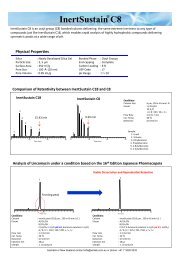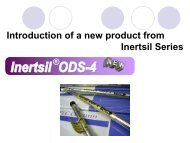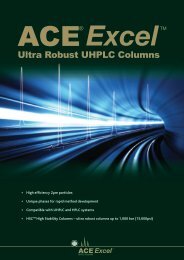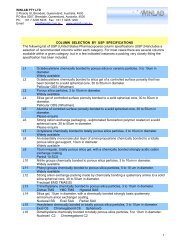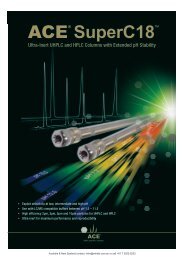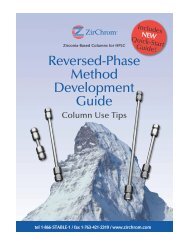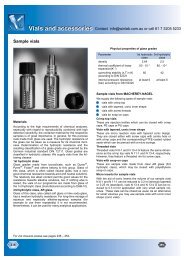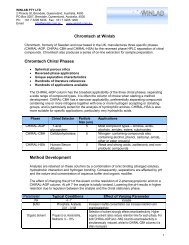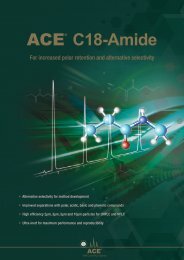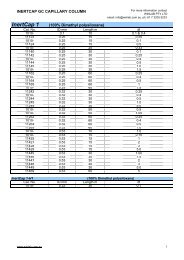Sepax Proteomix Brochure - Winlab.com.au
Sepax Proteomix Brochure - Winlab.com.au
Sepax Proteomix Brochure - Winlab.com.au
- No tags were found...
You also want an ePaper? Increase the reach of your titles
YUMPU automatically turns print PDFs into web optimized ePapers that Google loves.
<strong>Proteomix</strong> ® Ion-exchange PhasesGeneral Description<strong>Proteomix</strong> ion-exchange columns are specially designed forhigh resolution, high efficiency and high recoveryseparations of proteins, oligonucleotides, carbohydrates,and peptides. The packing support is <strong>com</strong>posed of a rigid,spherical, highly cross-linked poly(styrene divinylbenzene)(PS/DVB) bead. Both porous and non-porous PS/DVBbeads are provided. The porous PS/DVB resins haveparticle sizes of 5 and 10 µm with the pore size of 500 Å.The non-porous resins have particle sizes of 1.7, 3, 5 and10 µm. The PS/DVB resin surface is grafted with a highlyhydrophilic, neutral polymer layer with the thickness in therange of nanometer. The hydrophobic PS/DVB resin surfaceis totally covered by such a hydrophilic coating thateliminates non-specific bindings with biological analytes,leading to high efficiency and high recovery separations forbiomolecules. On the top of the hydrophilic layer, a layer ofion-exchange functional groups is attached via chemicalbonding. A proprietary chemistry was developed tosynthesize a densely packed, uniform ion-exchange layer.Chemical Structure of <strong>Proteomix</strong> ResinsThe chemical structure of <strong>Proteomix</strong> ion-exchange phasesis <strong>com</strong>posed of a rigid PS/DVB core, a densely packed,nanometer thick, hydrophilic coating, and a uniform ionexchangelayer, as shown in Figure 1.Hydrophilic LayerModifiedPS/DVBIon-Exchange GroupFig. 1. Schematic illustration of the chemical structure of<strong>Proteomix</strong> ion-exchange phases.Protomix Ion-Exchange PhasesAs shown in Figure 2, <strong>Proteomix</strong> ion-exchange phases are<strong>com</strong>posed of SCX, WCX, SAX, and WAX, which are strongcation exchanger with sulfonate functional groups, weakcation exchanger with carboxylate functional groups, stronganion exchanger with quaternary ammonium functionalgroups, weak anion exchanger with tertiary aminefunctional, respectively. All ion-exchange functional groupsare chemically bonded to the top of the hydrophilic coatingfor both porous and non-porous PS/DVB resins.SCXHO 3 S—WCXHOOC—SAX⊕—N(CH 3 ) 3WAX—N(C 2 H 5 ) 2Fig. 2. Chemical <strong>com</strong>positions of <strong>Proteomix</strong> SCX, WAX, SAX,and WAX phases.Highlights of <strong>Proteomix</strong> Non-Porous IonexchangeResins• Combined high capacity and high separation efficiency inone material• Particle size selection of 1.7, 3, 5 and 10 µm• Mono-dispersed particles• Tolerate high pressure operation: 4,000, 6,000, 8,000 and12,000 psi for 10, 5, 3 and 1.7 µm resins, respectively• Wide pH range: 2-12• High resolving power for slightly differed structures ofbiological species• 1.7 and 3 µm particles are best suitable for whole proteinseparation in proteome studies• Suitable for separations of peptides, carbohydrates andglycans, proteins, polynucleotides, cell lysates and multidimensionalseparationswww.sepax-tech.<strong>com</strong> 2 1-877-SEPAX-US



